Monitor "Oil Temperature" parameter on the scantool.
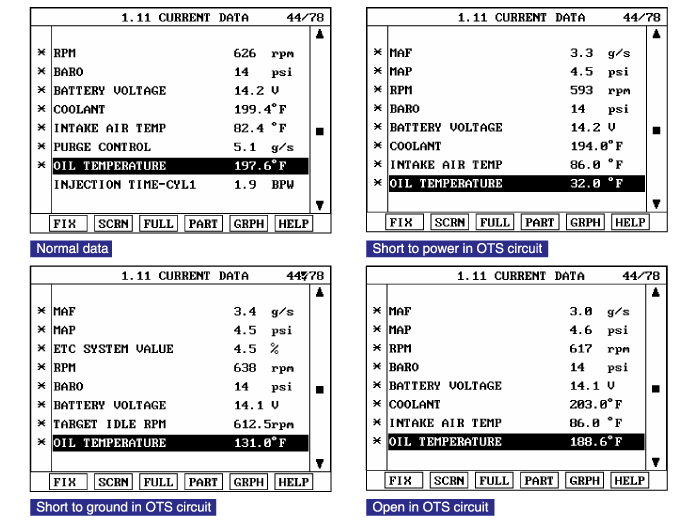
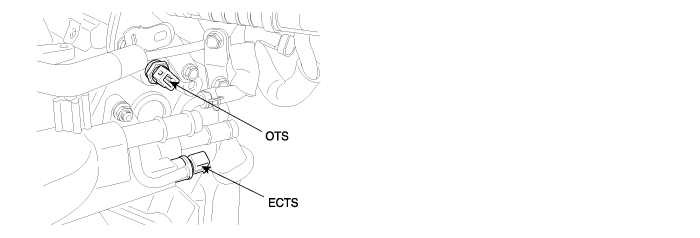
In CVVT system, the working fluid is engine oil. But its density varies according to temperature, PCM performs oil quantity correction based on the signal from engine oil temperature sensor over the various range of temperature. Main function of Oil Pressure Sensor is as follows.
intake air valve control solenoid(oil control valve) duty correction : As coil resistance varies according to oil temperature, excessive current flows at low temperture and low current at high temperature without duty correction. Therefore, PCM performs duty correction properly according to output signal from oil temperature sensor to supply constant current which is free from the change of oil temperature.
CVVT system operation starting temperature determination : As CVVT response gets weaker due to the friction of engine components such as valve at low temperature, PCM operates CVVT at above specific temperture based on output signal from oil temperture sensor.
improved CVVT controllability : CVVT response speed varies as oil temperature, PCM improves controllability throughout estimating response speed with oil temperture sensor output signal.
Checking output signals from oil temperture sensor every 15 sec. under detecting condition, if an signal is high for more than 12.5 sec., PCM sets P0198. MIL(Malfunction Indication Lamp) turns on when the malfunction lasts till consecutive 2 driving cycle.
Item | Detecting Condition | Possible cause | |||||
DTC Strategy | ● Signal low | ● Poor connection ● Open or short to battery in signal harness ● Open in ground harness ● Oil temp.sensor ● PCM | |||||
Enable Conditions | Case 1 | ● Engine running state 〉60 sec ● Coolant temperature 〈 110 ℃(230℉) | |||||
Case 2 | ● Engine running state 〉90 sec. | ||||||
Thresh old value | ● Oil temperature sensor's signal 〉4.9V | ||||||
Diagnosis Time | ● Continuous (More than 12.5 sec.failure for every 15 sec.test) | ||||||
MIL On Condition | ● 2 Driving Cycles | ||||||
Temperature(℃/℉) | Resistance(kΩ) | |||||
-20℃/ -4℉ | 16.52kΩ | |||||
20℃/ 68℉ | 2.45kΩ | |||||
80℃/ 176℉ | 0.29kΩ | |||||
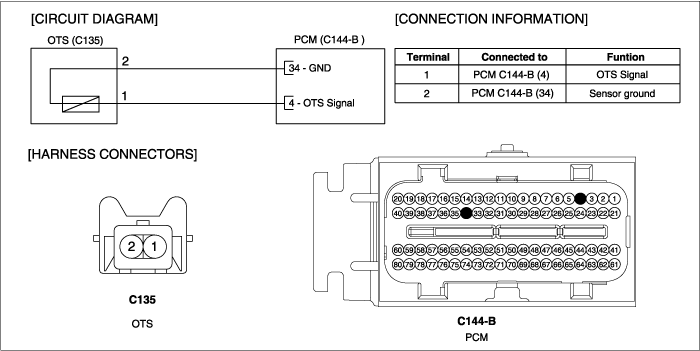
Connect scantool to Data Link Connector (DLC)
Warm up engine to normal operating temperature
Monitor "Oil Temperature" parameter on the scantool.

Is the current data displayed correctly ?

▶ Fault is intermittently caused by poor contact in the sensor and/or PCM connector or non cleared PCM memory after repair. Thoroughly check connectors for looseness, poor connection, bending, corrosion, contamination, deterioration, or damage. Repair or replace if necessary and go to "Verification of vehicle Repair".

▶ Go to "Terminal and connector inspection" procedure.
Many malfunctions in the electrical system are caused by poor harness and terminals. Faults can also be caused by interference from other electrical systems, and mechanical or chemical damage.
Thoroughly check connectors for looseness, poor connection, bending, corrosion, contamination, deterioration, or damage.
Has a problem been found?

▶ Repair or replace if necessary and go to "Verification of Vehicle Repair" procedure

▶ Go to "signal Circuit Inspection" procedure.
Check Voltage
IG "OFF" & ENG "OFF"
Disconnect OTS connector
IG "ON" & ENG "OFF"
Measure voltage between harness terminal 1 of OTS and chassis ground.
Specification : Approx. 5V
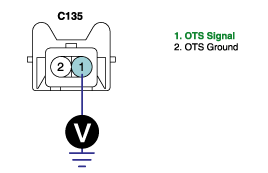
Is the measured voltage within specification ?

▶ Go to "Ground Circuit Inspection" procedure.

▶ Go to "Check open in harness" as follow.
Check open in harness
IG "OFF" & ENG "OFF"
Disconnect OTS and PCM connector.
Measure resistance between terminal 1 of OTS harness connector and terminal 4 of PCM harness connector.
Specification : Approx. below 1Ω
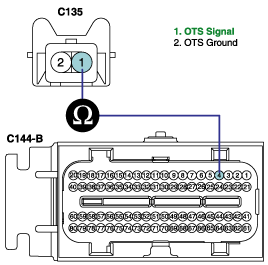
Is the measured resistance within specification ?

▶ Go to "Ground Circuit Inspection" procedure.

▶ Repair or replace open in harness, and then go to "Verification of Vehicle Repair" procedure.
IG "OFF" & ENG "OFF"
Disconnect OTS connector
Measure voltage between terminal 1 of OTS harness connector and chassis ground.
Measure voltage between terminals 1 and 2 of OTS harness connector.
Specification : Measurement "A" - Measurement 'B' = Approx. below 200mV

Is the measured voltage within specification ?

▶ Go to "Component Inspection" procedure

▶ Repair or replace contact resistance or open in harness and then, go to "Verification of Vehicle Repair" procedure.
Check resistance of OTS
IG "ON" & ENG "OFF"
Monitor Oil Temperature parameter on the scantool
IG "OFF" & ENG "OFF"
Disconnect OTS connector.
Measure resistance between terminal 1 and 2 of OTS connector(Component Side)
Temperature(℃/℉) | Resistance(kΩ) | |||||
-20℃/ -4℉ | 16.52kΩ | |||||
20℃/ 68℉ | 2.45kΩ | |||||
80℃/ 176℉ | 0.29kΩ | |||||
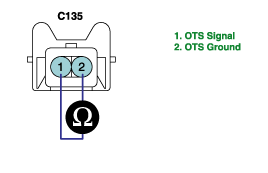
Is the measured resistance within specification ?

▶ Go to "Check PCM" as follows.

▶ Substitute with a known - good OTS and check for proper operation. If the problem is corrected, replace OTS and go to "Verification of Vehicle Repair" procedure.
Check PCM
Ignition "OFF" and Connect Scantool
Ignition"ON " & Engine "OFF"
Select simulation function on scantool.
Simulate voltage at terminal "1" of OTS signal harness connector.

Does the OTS signal value changes according to simulation voltage ?

▶ Thoroughly check connectors for looseness, poor connection, bending, corrosion, contamination, deterioration, or damage. Repair or replace if necessary and go to "Verification of Vehicle Repair" procedure

▶ Substitute with a known - good PCM and check for proper operation. If the problem is corrected, replace PCM and go to "Verification of Vehicle Repair" procedure.
There is a memory reset function on scantool that can erase optional parts automatically detected and memorized by PCM. After testing PCM on the vehicle, use this function to reuse the PCM on the others
After a repair, it is essential to verify that the fault has been corrected.
Monitor and record the Freeze Frame Data for the Diagnostic Trouble Code(DTC) which has been diagnosed.
Using a Scantool, Clear the DTCs
Operate the vehicle within conditions noted in the freeze frame data or enable conditions
Monitor that all rediness test have been verified as " Complete "
Are any DTCs present ?

▶ Go to the applicable troubleshoooting procedure.

▶ System is performing to specification at this time.